|
ENGINES &
TRANSMISSION
|
|
Behind its
strong personality and elegance, the new Ypsilon Sport
MomoDesign offers a comprehensive range of excellent
cutting-edge engines with generous performance: the
sparkling 1.4 16v petrol engine (95 bhp) and the two
Multijet 1.3 16v turbodiesels (90 and 105 bhp). Each offers
different features, all of which are exploited fully by
combining them with mechanical 5 or 6 speed gearboxes (the
1.4 can also be equipped with a 5-speed sequential robotised
DFN gearbox), which stand out for their generosity,
brilliant temperament or top performance and advanced
technology. However they all share superb reliability and
respect for the environment.
The 105 bhp and 90 bhp 1.3
Multijet 16v engine
The Ypsilon Sport MomoDesign range would not be complete
without the 1.3 16v Multijet engine, the smallest and most
advanced second generation direct injection Common rail
diesel unit, equipped with a variable geometry turbo. It is
available in two different versions, 90 bhp and 105 bhp,
which share the same architecture: 4 cylinders in line with
a capacity of 1248 cc, a bore of 69.6 mm and a ‘long’ stroke
of 82 mm. There are four valves per cylinder, governed
directly by twin overhead camshafts. That is not all. The
1.3 Multijet 16v is a miniature masterpiece: ‘dressed’ with
all its accessories, it weighs just 130 kg, it is small,
just 50 cm long and 65 cm tall, and the components are
arranged to take up as little space as possible.
The 1.3 16v Multijet delivers 105 bhp (77 kW) at 4000 rpm
and torque of 200 Nm (20.4 kgm) at 1750 rpm. And it doesn’t
end there. With the 105 bhp 1.3 Multijet and the 5-speed
manual gearbox, the new Ypsilon delivers excellent
performance that makes it the most powerful compact in its
category: it has a top speed of 177 km/h and accelerates
from 0 to 100 km/h in 10.3 seconds. Fuel consumption is also
among the best for this segment: 5.7 l/100 km in the urban
cycle, 4.1 l/100 km out of town and 4.7 l/100 km in the
combined cycle. And finally, CO2 emissions are also very
low, just 123 g/km. The performance of the second 1.3
Multijet is excellent too: a power delivery of 90 bhp (55
kW) at 4000 rpm and torque of 190 Nm (19.4 kgm) at 1750 rpm.
With this engine, the new Ypsilon has a top speed of 175
km/h, and accelerates from 0 to 100 km/h in 10.5 seconds,
with class-topping consumption: 5.4 l/100 km in the urban
cycle, 3.9 l/100 km out of town and 4.5 l/100 km in the
combined cycle.
The combustion system of the 1.3 Multijet has been modified,
increasing the permeability of the inlet and exhaust
manifolds, reducing the turbulence in the combustion chamber
and consequently modifying the geometry and the compression
ratio. The emissions control system incorporates an EGR
valve with electrical activation, managed directly by the
engine control system, a heat exchanger to cool the
recirculating exhaust gases (EGR) and a close-coupled
catalytic converter. This guarantees that the car meets Euro
4 emissions targets.
Designed by criteria of maximum rationality, efficiency and
reliability, the engine guarantees excellent efficiency and
is practically ‘for life’: it was designed to travel 250,000
km without needing any maintenance to the mechanical
components. Oil change intervals have been extended from
20,000 to 30,000 km, and the 1.3 Multijet 16v uses a low
viscosity oil, which means fuel economy and more respect for
the environment. The compact, sophisticated engine is also
environment-friendly, and it meets the Euro 4 emissions
limits even without a particulate trap (which is optional on
certain markets).
The 1.3 Multijet 16v therefore represents a technological
leap forward which, for the customer, translates into lower
consumption and emissions, without even taking into
consideration the reduction in noise (due to the multiple
injections), the increase in comfort (fewer alternating
masses means less vibration), the smooth, responsive
steering (due to the extremely smooth torque delivery, which
is guaranteed by the improved combustion control), the
elasticity and prompt response of a diesel that resembles a
petrol engine for the vast excursion in rpm (for example,
you are no longer aware of the fuel ‘cut-out’ just above
4000 rpm), or the ecological elements that enhance the
diesel’s main environmental credentials (consumption) while
minimising its main defect (particulate emissions),
particularly on the 90 bhp version, on which the DPF filter
is standard equipment.
The 95 bhp 1.4 16v Fire
engine
This engine has a capacity of 1368 cc, and 4 cylinders in
line, with a bore of 72 mm and stroke of 84 mm. There are
four valves per cylinder, activated directly by 2 overhead
camshafts. The engine was developed paying particular
attention to performance and to fuel economy, two areas in
which the Ypsilon Sport MomoDesign leads its class. The
merit goes to the volumetric efficiency which has been
optimised all through the operating range, thanks to a
precise fluid-dynamic calibration of the entire intake
system and the timing. The 1.4 engine delivers 70 kW (95
bhp) at 5800 rpm, and peak torque of 128 Nm (13 kgm) at 4500
rpm. Performance is excellent: the engine has a top speed of
175 km/h, and accelerates from 0 to 100 km/h in 10.9
seconds. It is a sparkling engine that delivers excellent
performance, achieved by the adoption of an electronic
throttle valve control system known as ‘drive by wire’.
|
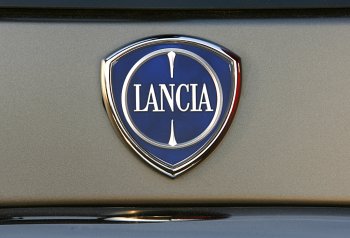
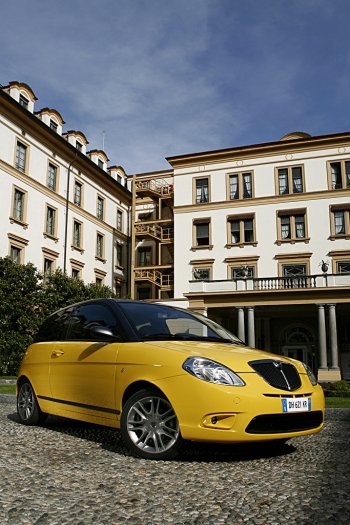
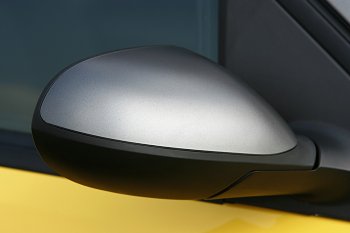 |
|
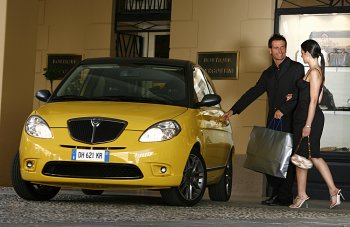
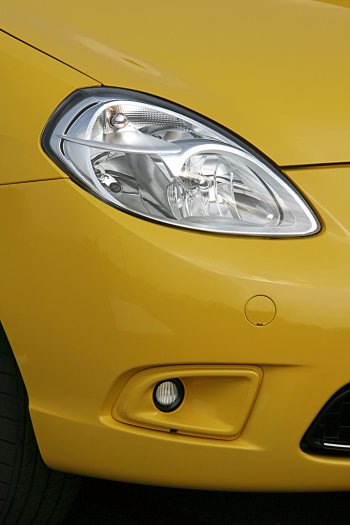
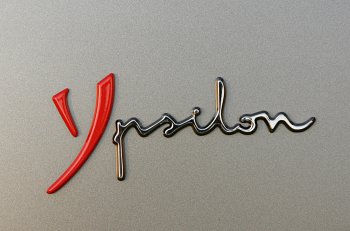 |
|
And also of a new high turbulence combustion chamber,
combined with continuously variable valve timing governed by
the control unit. This innovative system allows a large part
of the exhaust gases (about 25%) to be ‘recirculated’ in the
combustion chamber, significantly reducing fuel consumption
and exhaust emissions when driving with a partial load. And
last but not least, the engine incorporates a number of
fuel-saving steps. For example, the timing components have
been made lighter and the valve springs are of the low load
type, to reduce friction.
Other features peculiar to the new 1.4 Fire engine are the
increased compression ratio (11:1) and the high torque
values at low speeds, characteristics that make it possible
to limit fuel consumption. This was also achieved by the
calibration of the latest generation engine control unit,
which keeps fuel consumption very low, compatible with the
demand for drivability, performance and low emissions. We
should underline that the 1.4 Fire engine is in line with
Euro 4 legislation, thanks to the catalytic converter in the
engine bay (welded to the exhaust manifold flange using a
new technology), which reaches very high temperatures
faster, thus reducing emissions even while the engine is
warming up. To minimise the environmental impact, the engine
also incorporates a returnless fuel supply system, which
eliminates fuel recirculation within the tank, and reduces
vapour formation.
The ‘DFN’ gearbox
The 95 bhp 1.4 16v Fire engine can be combined with a
robotised manual 5-speed gearbox with automatic control.
This automatic control makes the device extremely convenient
to use, particularly after you have enjoyed the excitement
of a sporty dynamic drive with the manual transmission,
which is why it has been nicknamed ‘Dolce Far Niente’. The
DFN gearbox has an innovative transmission system with an
electrohydraulic servo device that automates the clutch
controls and gear lever but retains all the advantages of a
dry clutch and mechanical gearbox (weight, strength and
reliability, low energy consumption). It is a balanced
system, which improves the performance of the manual
transmission components while increasing driving safety
because it avoids errors by the driver and prevents
incorrect manoeuvres of the transmission system.
There are two operating modes: semiautomatic and automatic.
The first adopts the most advanced control strategies to
guarantee best performance. Gears are engaged using the
lever on the tunnel. Because there is no clutch pedal, the
device is controlled simply by moving the lever: forward to
change up (towards the ‘+’ symbol), back to change down
(towards the ‘-’ symbol). A simple push is sufficient to
ensure the transmission makes a fast, accurate gear change.
This is how the DFN transmission functions in semiautomatic
mode. The electric signals reach the control unit by CAN
(Controller Area Network) and can be grouped in two large
subgroups. In one, the data from the gearbox area, which
make it possible to identify the engagement position, the
selection, the clutch, and the operating pressure of the
hydraulic kit, as well as the rotating speed of the clutch.
In the other, all the signals coming in from the other
systems on the Lancia Ypsilon (for example, the engine and
braking system), which help to define the gear change
precisely and repeatably. Using these two groups of signals,
the DFN gearbox can manage gear changes in a comfortable or
sporty way, in manual or automatic mode, with the different
operating logic, interpreting the driver’s needs by
analysing pedal position (interpreted as a request for power
as the values increase) and engine speed.
Once the engine on the Ypsilon Sport MomoDesign is started,
any pressure on the brake pedal confirms that the driver is
at the wheel, and enables first or reverse to be engaged (on
a slippery surface it is also possible to set off in
second). And to guarantee safety and prevent incorrect gear
engagement, the system engages neutral automatically when a
door is open with the engine running. The device also
prevents errors that might damage the engine or gearbox, by
notifying the driver of emergency situations or incorrect
manoeuvres with warning lights and beeps. The automatic mode
of the DFN gearbox offers two settings: Normal and Economy.
The Normal setting offers outstanding driving comfort, with
brilliant acceleration and gear changes in all conditions.
The Economy setting is used to reduce fuel consumption,
while still maintaining top level handling and comfort.
With both options, the system stretches to a higher ratio
once the rpm level has been reached, when the engine
delivers maximum torque or power. In automatic mode, the
system recognises the road gradient (by means of a software
algorithm) and modifies the gear shift point to ensure the
best possible compromise between the driver’s needs, ground
conditions and vehicle situation (speed and engine rpm).
Another feature peculiar to the DFN gearbox is its ability
to measure vehicle deceleration and adapt gear changes
accordingly. For example, in semiautomatic mode, and
particularly with a sporty driving style, the system changes
down when the driver asks for a lower gear to take a corner
at a faster speed. In automatic mode, the system anticipates
the change down so that the driver has the best speed to
maintain the level of comfort or fuel economy. The DFN
gearbox is the best compromise for drivers who prefer the
enjoyment and entertainment of a manual shift, but like to
know they can count on the convenience of an automatic. |
|